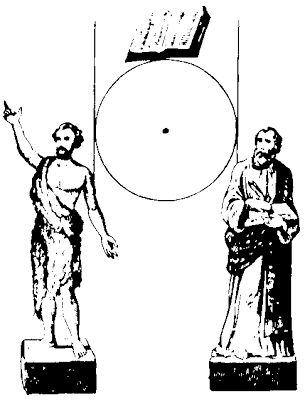The holidays are upon us, which means many of us are scrambling to buy our wives and kids that gift we should’ve secured months ago. There are 14 religious holidays in December – and one masonic festival, the Feast of St. John the Evangelist, on December 27th.
As freemasons, one of the first lessons we learn is that lodges are erected to God and dedicated to the Holy Saints John of Jerusalem (John the Baptist and John the Evangelist). This line is oftentimes recited, but seldom understood. Neither John the Baptist, nor John the Evangelist were stonemasons by trade. At the time of starting this article, why these men were chosen as our patron saints is far beyond my understanding. That said, I hope to answer that question by the end of this article.

The masonic symbol above depicts John the Baptist zealously preaching the word of God, with John the Evangelist grasping a book and writing. The two parallel lines on opposite sides of the illustration signify the two men being opposites in their approach to life and their office. The circle refers back to the compasses, and the bounds in which we are to circumscribe our desires, with the dot referring to the microcosm (us as individuals) and the perfect equilibrium we strive to meet. Both men represent opposing but complementary virtues as the extremes to which our passion and thought (perhaps consideration) should extend, acknowledging both are necessary for an integrated man. Above all of these is the Volume of Sacred Doctrine, advising the viewer to refer to your religion in how best to achieve this balance.
Now that we are aware of John the Evangelist’s association with concepts surrounding thoughtfulness, we can work to better understand the man, and perhaps the Feast of Saint John the Evangelist and how we as Freemasons should observe it. The holiday, as all things pertaining to the saints, finds its roots in the Catholic Church, which provides a beautiful explanation for the holiday.
Some translations of the scripture identify John as the “beloved” disciple of Jesus in John 21:20. While this is partially speculation, it’s worth considering John was the only individual Jesus entrusted Mary (his mother) to at the crucifixion (John 19:26-27). Even in depictions of the last supper, John is depicted at the right hand of Jesus. He was the only disciple at the base of the cross and was among the three who went to inspect the tomb.
Jesus clearly had a close bond with John – closer than his other disciples. At this point, we’re driven to ask why. What set John apart from Peter, Mark, Phillip, Bartholomew and the other disciples? A direct answer to this question has unfortunately proven elusive. Perhaps the answer is simply that Jesus could trust John as if he were a brother. Mary wasn’t entrusted to Peter. Nor did Jesus, the eldest of 5 brothers, entrust her to his own siblings. He was so confident in John, that he essentially adopted him into the family. This display of fraternal love, recognizing our adopted brothers’ families as our own, is what I believe the Feast of St. John the Evangelist means in the context of Freemasonry.
Every year, around the holidays, many lodges across the country tend to perform small acts for our widows. Typically, this entails the simple act of delivering poinsettias to their doors. In my early years as a mason, I didn’t see the value here. It all seemed trivial to me. However, working through this article, I’ve grown to see this tradition in a new light. While these small acts of kindness are a way to help make our widows’ holidays brighter, they’re just as much an exercise and reminder of the brotherly love we should strive to achieve that John the Evangelist exemplified so well.